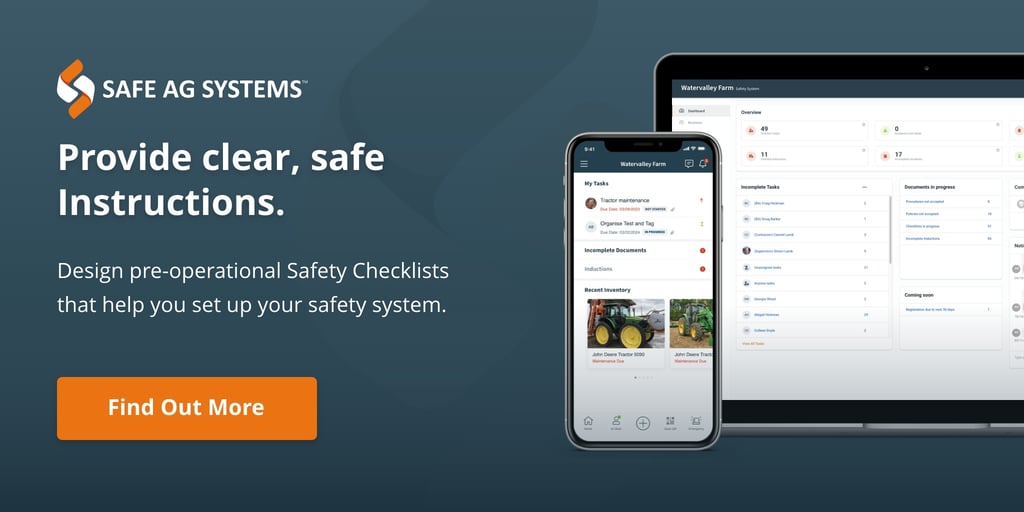Safety checklists are a fundamental part of your farm’s safety and compliance. Checklists are known for assisting with repetitive tasks, ensuring we move quickly and smoothly through a process. Generally, safety checklists are written, defining how to complete a task with minimal risk.
Whether you are using a checklist for a piece of farm machinery maintenance, a safe operating procedure or worker induction, checklists are created to make things safer and here we are going to address the reason why.
What is a safety checklist?
One of the simplest safety management tools, an agricultural safety checklist encourages best practice, and while they might be viewed as tedious and repetitive, they can remind us to not cut corners. Often safety checklists are used as part of your inspection process, they assist in identifying potential hazards and making recommendations specific to your farm.
Safety checklists make us reconsider our actions and at the end of day, might just save a life.
What are the benefits of a safety checklist?
Saving you time and reducing the risk
We can all agree that checklists are a simple tool to help mitigate mistakes. They ensure consistency across repetitive tasks, outlining each step so nothing is left to chance. Your checklists set the standard for workers and contractors, so they know exactly what to do and how to do it. With multiple people onsite, documented checklists mean you spend less time communicating and supervising each time a task is completed.
Accountability
In Australia, legislation specifies that workers, contractors and PCBU have the responsibility of ensuring a safe workplace. It is your duty of care to provide a safe working environment. As part of this legislation, employers are required to consult with workers to identify foreseeable hazards that have the potential to cause harm. Once the hazard has been identified, effective procedures must be in place to control the risks and hazards.
Hazard identification
Checklists can assist your team in identifying potential health and safety problems on your farm. This could range from manual tasks, machinery and equipment, environmental factors including liquids, surfaces, noise and extreme weather conditions. Safety checklists reduce the probability of a workplace accident by ensuring your workers are aware of their surrounding environment.
Hazard identification checklists examine your workplace conditions and procedures. It encourages your workers to observe their workplace, recognizing items that may be out-of-place, assessing the hazard and identifying any causes. Once identified, you can take action to control the hazard by elimination, if you cannot eliminate the hazard, you can determine substitutions, it’s all about risk mitigation.
Checklists assist your agribusiness in several ways, they can help identify and tagout damaged equipment, communicate how chemicals can be mixed, stored and the appropriate PPE required when handling. They ensure your workers understand how to act and what to look for.
Emergency preparedness
We know farms aren't recognised for being the safest working environment, but by using checklists our workers are prepared. Prepared for the potential dangers and ready to act if a hazardous situation does arise. This conscious effort and preparation ensure we can act quickly in an emergency. We know every second counts, whether that involves fire, electric shock, chemical exposure, or an accident involving a farm vehicle. How do safety checklists assist in this kind of situation?
- The first aid kit has been reviewed for out-of-date products and restocked
- Your firefighting equipment is tested regularly, maintained, and accessible
- Workers know the procedure, or at least where to find the emergency plan and contacts
- Everyone is alert to the hazards of any machinery, tools and equipment involved
Pre-operational Checks
Keep track of the condition of your machinery by attaching pre-operational checklists. These pre-operational checks could be performed daily, weekly, and monthly helping you stay on top of inspections. Your workers can ensure machinery and equipment is safe for use at the start of each day, identifying any defects and monitoring functionality.
Maintaining a safe workplace requires your team to regularly complete checklists, carry out inspections, ensuring your machinery, tools and equipment are in working order. This involves not only visual inspections including no leaks or damage, but testing functions such as horns, alarms, steering and brakes. Not to mention utilising this reporting process to drive change and evaluate control measures in your agribusiness.
Completing a checklist should follow the below steps;
- Look
- Identify
- Assess
- Control
- Monitor
Make Health and Safety Checklists easier with Safe Ag Systems
Built to accommodate both family owned and corporate farming, Safe Ag Systems focusses on predictive compliance and improved safety on farm. Safety management software created for managing worker health and safety, and compliance, Safe Ag Systems was designed for practical application on farm.
As the system is designed to train and gather records in real-time and remove the physical paperwork, Safe Ag Systems has over 150 Safety Checklist templates available to help you set up your safety system easily and efficiently. Workers can complete a checklist utilising their mobile or tablet, add actions or a task, and attach images or links for more information.
Our range of Health and Safety Checklists and Pre-operational Checklist Templates include:
- Fatigue Self-Assessment Checklist
- Fit for Work Checklist Template
- Quad Bike Checklist Template
- Telehandler Checklist Template
- Tractor Checklist Template
- Visitor/Staff Biosecurity Risk Assessment Template
- Toolbox Talk Template
Topics: Safety Management System
Disclaimer: Content on this website may be of relevance to users outside of Australia, but content links and examples are specific to Australia. Please check with your local authority for your country and industry requirements.











